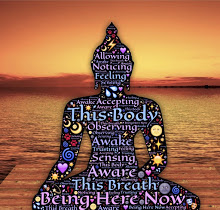QUESTION: We hear a lot about "not self" (anatta) in Buddhism. How do we incorporate this teaching into our meditation practice?
ANSWER: If one is practicing right-mindfulness (bare awareness free of clinging, thinking/judging, or identifying with, then one is already wisely applying the Dhamma to deal with all planes of existence. In all planes, there are Three Universal Characteristics of all phenomena. All things are impermanent (so it is wise not to cling), disappointing (so it is wise not to expect them to be able to satisfy or fulfill us), and impersonal (so it is wise not to identify with them).
 |
| Youngish adults sometimes ask best questions |
Moreover, there comes a time, when we have mastered serenity practices (shamatha, samma-samadhi) and we take up insight practices (vipassana) in earnest. This is when we practice Dependent Origination to know-and-see the origin of all things currently arising. During this time, with an appropriate teacher like Pa Auk Sayadaw or one of his many authorized teachers, we "break down the compactness" and see the constituent nature of phenomena. And there is nothing more fundamental in this regard than the "self" (atta, atman).
.png) |
| Weekend retreats, Benedict Canyon, Beverly Hills |
By letting go in this way (naturally as a result of seeing how it really is), now no longer clinging but instead detaching, we arrive at the first stage of enlightenment with no effort to reject or push away.
This is known as stream entry (the first stage of enlightenment) what is impossible to see without a Buddha's great awakening: identifying and clinging to (or fearing and trying to annihilate) a "self" is the fundamental delusion.
- Wait! If there is no "self," what is there? What is ALL this? (What is the "all" the Buddha is talking about in the "Fire Sermon" when he says, "All is burning"?) In a conventional sense, there is a self (atta, atman, an ego, a personality, him, her, that one over there, this one over here pointing at that one over there). That should not confuse or surprise anyone. What is shocking, upsetting, and unacceptable (mindboggling and impossible and crazy) is that, in an ultimate sense, there is "not a self (anatta)." Or a better way to say it is that, ALL that we think of as a "self" is not true of this self (that it is eternal, that it is bound for annihilation at death, that it is able to fulfill us or be satisfied, or that it is personal and us and can be identified with, or be under our control, and so on). Sometimes it is said that there is no "separate self," as if there were a self (our True Self, our Higher Self, that is all One and advaita, and this is very beautiful, but it goes askew because it is still identification with something. Maybe this view should be given a pass because wiser people cling to it so much and think they have found a solution to the radical and unacceptable thing the historical Buddha was saying. (Here's looking at you, Mahayanists): It is not that there is a self, and it is just not separate from everyone and/or everything else. It is that what the self is not separate from are the aggregates, the heaps, the khandha, the skandhas. The Heart Sutra says this very poetically, and everyone fails to understand except a bodhisattva like Avalokiteshvara every so often. The "self" is not separate from those ephemeral phenomena that are not a self: the illusion of self is arising (co-arising) upon those phenomena. Therefore, what there is, in a sense -- if there is ultimately no self and ALL things are impersonal -- are seven things: (1) Dependent Origination, (2) illusion (maya), and (3) the Five Aggregates clung to as a self. Or be more specific and increase the number of elements on this list: 1-12 causal links in Dependent Origination + illusion (ignorance, identification, clinging) + Five Aggregates (eight more things, half of them "form" and the other four "mind") = 23 things or keep going. There will not suddenly come into being a "self" within these, as the owner of these, or apart from these. Thinking about it too much is only stirring our defilements (not our defilements, obviously, but the ones being identified with). It is far better to practice calm and insight to know-and-see directly and thereby gain freedom. The Truth shall set one free. But the limitations of language keep acting as stumbling blocks to believing what need not be "believed." One approach and see for oneself. The Dharma is inviting, open to investigation, and the Buddha never asked for blind faith, just that people come see for themselves.

Without realizing the true nature of "self" (soul, ego, personality, a "being" that is in fact always becoming and never static), there is no breakthrough to noble knowledge-and-vision of things as they truly are and their transcendence.
WHERE AND WHEN?
- Santa Monica Meditation Center | InsightLA
- Sunday nights, 7:00 to 8:30 pm
- 1430 Olympic Bl., Santa Monica
- Los Angeles, California 90404
- Meetup: Dharma Buddhist Meditation
- WhatsApp: chat.WhatsApp.com/D5zsBZlmGel5mR9ctzEknP
- Website: insightla.org
- Practice Group: Youngish Adults (20s, 30s, 40s) Practice Group - Santa Monica/Online - InsightLA Meditation
- Dhr. Seven, Ananda (Dharma Buddhist Meditation), Jen Bradford, Wisdom Quarterly; Eileen Ybarra (guided meditation instruction), Insight Los Angeles (insightla.org)


















































































































































































































































No comments:
Post a Comment